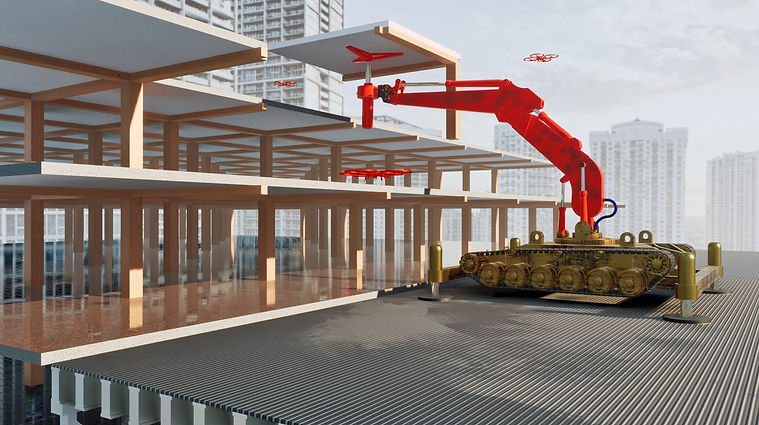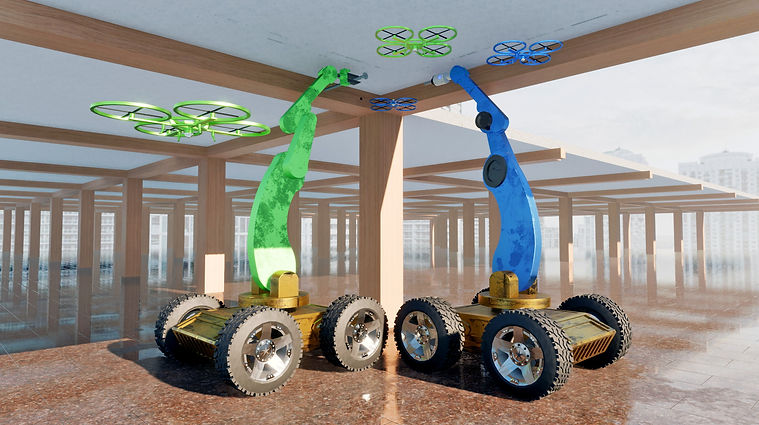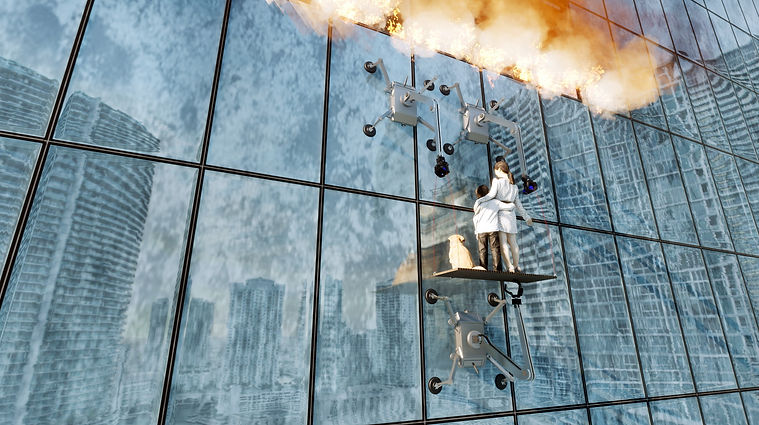

Dr. Lu's Studio 盧博設計工坊
ECO生態‧Art藝術‧Tech科技
Distributed AI Robot Series
分散式AI機器人系列
Why is the distributed AI robot series of public welfare inventions so important? Because it concerns each and every one of us.分散式AI機器人系列公益發明為何如此重要,因為關係到你我每一個人。

Public Welfare Invention Benefiting the World: Distributed AI Robots 造福世界的公益發明:分散式AI機器人
1.The invention of distributed AI robots is aimed at public welfare, distinguishing itself from the mainstream technological development that primarily focuses on profit generation, making it particularly unique.
2.While mainstream AI robots tend to be humanoid or biomimetic, these types of robots possess high commercial value and emphasize entertainment. However, humanoid robots are highly inefficient; for instance, two wheels are far more efficient for movement than two legs. Furthermore, the human body has blind spots in both vision and limb movement, making it unreasonable for robots to replicate human functionalities.
3.AI robots excel at performing singular and repetitive tasks. Thus, he categorizes the robots into two types: those for heavy labor requiring strong power output—utilizing hydraulic rods—and those for precision tasks—using motors and gears. Conventional humanoid robot fingers are constructed with small gears and motors that cannot output significant force; hence scenarios depicted in science fiction where robots lift vehicles are unrealistic.
4. Only humans can replace or even destroy another person, but tools cannot. Your hoe will not go and destroy another person on its own. The probability of humanoid AI robots destroying humans is much greater than that of tool-type AI robots. His distributed AI robots are the real good helpers of humans.
1.分散式AI機器人的發明是以公益為宗旨,有別於科技發展主流的以創造利潤為出發點,因此特別與眾不同。
2. 主流AI機器人朝向人型或仿生型機器人為主,然而這樣的AI機器人有著高度商業價值,著重休閒娛樂,但人型機器人是非常沒有效率的,光是移動,兩輪就比雙腿有效率得多,而且人體不論視覺還是肢體活動,都是便於向前,背後都是死角,機器人完全沒理由照抄人體機能。
3. AI機器人最擅長的是單一且重複性的工作,因此他將機器人依粗工與細活分兩類,粗工需要強大的力量輸出,所以要用液壓桿,細活需要精準,所以採用馬達與齒輪;一般人形機器人的手指關節是使用小型齒輪與馬達構成,無法大力量輸出,科幻電影裡機器人一手抓起車輛的情節,在現實是不可能發生的。
4. 只有人會取代甚至消滅另一個人,而工具不會,你的鋤頭不會自己跑去消滅另一個人,人形AI機器人消滅人類的機率,遠大於工具型AI機器人,他的分散式AI機器人才是人類真正的好幫手。
Distributed AI Architectural Robot 分散式AI 建築機器人
In the architectural domain, heavy-duty AI robots—illustrated in Figure 1 as "Distributed AI Architectural Heavy-Duty Robot"—feature an internal AI computer for safety and heat dissipation purposes made from brass. They move on tracks and have jacks at each corner to stabilize the body before lifting heavy objects. The upper part of the body includes a rotating platform connected to the robotic arm via three hydraulic rods, allowing for 360-degree rotation and powerful force output. The joints between the arm and elbow as well as between elbow and hand are also driven by hydraulic rods with concealed piping to prevent damage during operation. The hand can be swapped based on task requirements, necessitating corresponding AI training.
以建築領域為例,做粗重工作的AI機器人,如圖一所示,為「分散式AI建築粗工機器人」,車體內部因有AI電腦主機,基於兼顧安全強度與散熱,採用黃銅,並以履帶行進,且為了更好的搬運重物,四個角落設有千斤頂,在搬運前,升起車體打樁,以穩固機身;車體上方設有轉盤,機器手臂的臂膀與轉盤以三根液壓桿相連,提供360度旋轉且強大的力量輸出,臂膀與手肘、手肘與手掌,連接處都是以液壓桿驅動,液壓管路採隱藏式走線,避免作業中損壞;手掌可以依任務需求更換,同時AI也要經過相對應的訓練才行;此處要搬運像素化建築模塊,模塊採用全鋼打造,並以仿木與仿大理石工法美化,且立柱與橫樑都是鋼材,採用鋼構榫接加螺絲固定以提供強大的地震與颱風防護力,因此機器人手掌採用三指大掌,穩定的將模塊搬到定位並加以榫接。

Fig.1, Digital twin show of distributed AI architectural rough-work robot.分散式AI建築粗工機器人的數位孿生展示圖
For fine work, once the architectural modules are assembled using mortise joints, they need to be secured with screws requiring another robot—depicted in Figure 2 as "Distributed AI Architectural Fine Work Robot." This robot also contains an AI computer and a rotating platform but moves on wheels since it does not require jacking or heavy force output. The task of screwing is divided between two robots: one (the green robot) uses a two-finger grip to position screws while the other (the blue robot) uses an electric screwdriver to secure them.
接下來是細活部分,榫接好的建築模塊須再以螺絲固定,因此需要有機器人來執行,如圖二所示,為「分散式AI建築細活機器人」,車體同樣有AI電腦主機與轉盤,因不需要打樁與大力量輸出,所以用輪子移動,手臂的驅動全採用馬達與齒輪,鎖螺絲雖是簡單工作,但為了將效率最大化,由兩個機器人分開執行,一個將手掌換成二指握持,為綠色機器人,將螺絲拿到螺絲孔處放定位等待,另一個將手掌換成電動螺絲起子,為藍色機器人,將螺絲鎖好。

Fig. 2, Digital twin show of distributed AI architectural fine-work robot.分散式AI建築細活機器人的數位孿生展示圖
Distributed AI Rescue Robot 分散式AI 救援機器人
In rescue operations within urban high-rises—often curtain wall buildings with smooth glass facades—rescue efforts become extremely challenging during fires. If there were an AI robot capable of climbing walls effortlessly (illustrated in Figure 3), it could safely rescue trapped individuals. This "Distributed AI Rescue Robot" features a skeleton made from 7075 aluminum alloy—offering near stainless steel hardness at only one-third the weight—with excellent thermal conductivity.
以救難領域為例,都市高樓大多是帷幕大樓,牆體是光滑的帷幕玻璃,發生火災時,攀爬施救非常困難,這時如果有能夠爬牆如履平地的AI機器人,就可以安全的拯救受困的人們,而這款“分散式AI救難機器人”,圖三是其數位孿生機體展示圖。

Fig. 3, Digital twin body show of distributed AI rescue robot.分散式AI救難機器人的數位孿生機體展示圖
The chassis frame utilizes 7075 aluminum alloy, offering hardness approaching that of stainless steel at only one-third the weight. Furthermore, its thermal conductivity of 130 W/mK is substantially higher than stainless steel, ensuring efficient heat dissipation for the onboard AI computer. Given that rescue scenarios preclude the use of air cooling, the system employs a nano-carbon liquid cooling radiator—an invention previously patented by Dr. Hung-Chih Lu—which concurrently minimizes total weight. The external shell is fabricated from stainless steel for cost-effectiveness, providing excellent resistance to corrosion and wear, thereby shielding the internal mechanics and electronics from external elements.
機身骨架採7075鋁合金,硬度接近不銹鋼,但重量只有1/3,且導熱係數130w/mk,遠高於不銹鋼,能給AI電腦提供良好散熱,因為救難需求,風冷散熱不可用,必須採用盧鴻智博士先前公開的發明-奈米碳液冷散熱器,同時降低整體重量;外殼則採用不銹鋼,降低成本同時,還提供了優異的耐腐蝕性和耐磨性,能夠保護內部結構和電子元件免受外部環境的影響。
The robot's feet are an improved iteration of a conventional vacuum suction cup mechanism. A compact electric actuator links the upper portion of a lever to the lower leg assembly. In a "0" signal state, the actuator retracts, positioning the lever vertically to disengage the suction cup and enable a forward step. Conversely, in a "1" signal state, the actuator extends, shifting the lever horizontally to engage the suction cup, firmly fixing the foot to a curtain wall. This allows the robot to methodically ascend a vertical surface step by step.
機器人四肢的腳掌採用常見的真空吸盤結構再加以改良,在撥桿的上方銜接小型電動推桿,另一端連接在小腿處,如此當電子訊號為”0”的狀態,小型電動推桿收縮,撥桿成垂直狀態,真空吸盤為放開,機器人的腳可以跨步前進,當電子訊號為”1”的狀態,小型電動推桿伸長,撥桿成水平狀態,真空吸盤為吸附,機器人的腳可固定在帷幕牆上,如此一步步在垂直牆面上緩步前進。
During rescues (shown in Figure 4), two robots cooperate by gripping both ends of a platform while the rescued individual stands on it. With drone-assisted visual systems, they can safely descend to the ground without fatigue as long as power supply and cooling systems remain operational.
在施救時,如圖四所示,分散式AI救難機器人採用兩機協作,機器手臂分別握持吊板兩端,待救者站在吊版上,在無人機視覺系統輔助下,緩步安全的爬向地面,拯救受困者,由於AI機器人不會疲累,只要電力充足且散熱良好,都可以持續運行,解救受難者。

Fig. 4, Digital twin rescue demonstration of distributed AI rescue robot.分散式AI救難機器人的數位孿生救援演示圖
Notably, these AI robots do not have fixed cameras; instead, they utilize multiple drones equipped with life detection functions providing comprehensive environmental data through various imaging technologies.
特別的是,這些AI機器人的眼睛都不是固定安置在機器人身上,而是採用多台無人機做眼睛,其內建生命探測功能,除了全景鏡頭以外,還有紅外線成像、聲波探測、光學成像與雷達�探測等,提供遠近多角度的全方位視野,獲得無死角的環境數據。
Distributed AI SAR Robot 分散式AI 搜救機器人
In emergency situations such as aircraft crashes at sea or capsized vessels—where communication devices may be damaged and the accident location cannot be pinpointed—rescue operations face enormous challenges. Traditional carpet searches are not only time-consuming and labor-intensive but also lack reliable references in the vast ocean. Every minute is critical when it comes to the lives and safety of those in distress. Now, Dr. Hung-Chih Lu’s distributed AI search and rescue (SAR) robot emerges like a ray of hope, bringing a revolutionary solution to maritime rescue.
在海上飛機失事或船隻翻覆的緊急情況下,若通訊設備損毀,無法準確掌握失事地點,救援工作將面臨巨大挑戰。傳統的地毯式搜索不僅耗時費力,更在茫茫大海上缺乏有效依憑,而每一分每一秒都極為關鍵,關係到受難者的生命安危。如今,盧鴻智博士的分散式AI搜救機器人宛如一道曙光,為海上救援帶來了革命性的解決方案。
Innovative Design for All-Around Search and Rescue創新設計,全方位搜救
The distributed AI SAR robot, as shown in Figure 5, is designed based on the concept of a Bee Swarm, with a drone flight structure serving as its mobility platform. Its main body is equipped with life-detection cameras on all sides—front, back, left, right, top, and bottom. In addition, several drones serve as “eyes,” with their keen vision capturing signs of life from every angle, thereby expanding the search range and enhancing efficiency. The bottom of the main body features a primary robotic arm, while four legs facilitate stable ground placement; these legs retract during flight to avoid disrupting airflow, ensuring stability and safety.
分散式AI搜救機器人如圖五所示,是以蜂群為主概念、無人機的飛行架構作為移動裝置,其主機體的前後左右上下均安置了具備生命探測功能的攝像頭,此外,還配備了數架無人機作為”眼睛”,一雙雙敏銳的眼睛,能夠全方位捕捉生命跡象,進一步擴大搜索範圍和提升搜索效率。主機體底部設計了主手臂,另四隻腳便於在地面停放,而在飛行時則會收起,避免干擾氣流,確保飛行的穩定性和安全性。

Fig. 5, The Overview of The Distributed AI SAR Robot分散式AI搜救機器人的機體展示圖
Efficient Collaboration for All-Weather Rescue高效協作,全天候救援
When a maritime disaster occurs without any available information about the accident location, as shown in Figure 6, the swarm-like fleet of “eye” drones is rapidly deployed to perform a carpet search. Simultaneously, a dedicated “Hive” — a Mothership vessel—designed for charging and basic maintenance of the drone fleet—provides robust logistical support. Once the drones detect a victim, the main body immediately mobilizes to conduct the rescue. During the operation, a two-unit collaboration method is employed: the primary robotic arm holds both ends of a boarding plank on which the victim stands, ensuring the stability and safety of the rescue process.
當獲知發生海難且無失事地點相關情報時,如圖六所示,蜂群般的”眼睛”無人機群將迅速出動,進行地毯式搜索。與此同時,一艘專供機群充電與簡易保養的”蜂巢”船艦隨行,為無人機群提供強有力的後勤支援。一旦無人機群探測到受難者,主機體便立即出動前往營救,施救時採用兩機協作的方式,主機器手臂握持吊板兩端,受救者站在吊板上,確保救援過程的穩定性和安全性。

Fig. 6, The Digital-Twin Demonstration of The Distributed AI SAR Robot分散式AI搜救機器人的數位孿生海難救生演示圖
Thanks to the ample charging and maintenance provided by the “Hive”, the drone fleet is capable of continuous, 24-hour all-weather search operations. In this race against time, the distributed AI SAR robot’s efficient collaborative capability and round-the-clock operational mode enable it to locate victims as quickly as possible, thereby securing crucial time to save precious lives.
憑藉“蜂巢”提供的充足充電與保養,機群能夠實現24小時不間斷的全天候搜索。在這爭分奪秒的救援過程中,分散式AI搜救機器人以其高效的協作能力和全天候的作業模式,能夠在最短時間內發現受難者,為拯救寶貴生命爭取到關鍵時間。
Technological Breakthroughs Leading a New Trend in Rescue技術突破,引領救援新趨勢
Dr. Hung-Chih Lu’s invention is not only ingeniously designed but also represents a significant technological breakthrough. Its distributed AI system enables autonomous collaboration and intelligent decision-making among the drone fleet, dynamically adjusting search strategies based on the environment and mission requirements. This greatly improves search accuracy and coverage. At the same time, the introduction of the “Hive” vessel addresses the limited endurance of the drones, allowing rescue operations to continue without time constraints.
盧鴻智博士的這項發明不僅在設計上別具匠心,更在技術上實現了重大突破。其分散式AI系統能夠實現無人機群的自主協作和智能決策,根據搜索環境和任務需求動態調整搜索策略,大大提高了搜索的精準度和覆蓋率。同時,”蜂巢”船艦的設置解決了無人機續航能力有限的問題,使得搜救行動能夠持續進行,不受時間限制。
Broad Application Prospects, Benefiting Humanity應用前景廣闊,造福人類
The application prospects for this distributed AI SAR robot are extremely broad. Beyond maritime rescue, it can also be applied to emergency responses for natural disasters such as earthquakes and floods, as well as search and rescue missions in complex environments like mountains and forests. Its efficient search and rescue capabilities and all-weather operation will bring profound changes to the emergency response field, making significant contributions to protecting human life and reducing disaster losses.
分散式AI搜救機器人的應用前景極為廣闊。除了海上救援外,還可應用於地震、洪水等自然災害的救援工作,以及山地、森林等複雜環境的搜救任務。其高效的搜救能力和全天候的作業模式,將為應急救援領域帶來深刻的變革,為保護人類生命安全和減少災害損失做出重要貢獻。